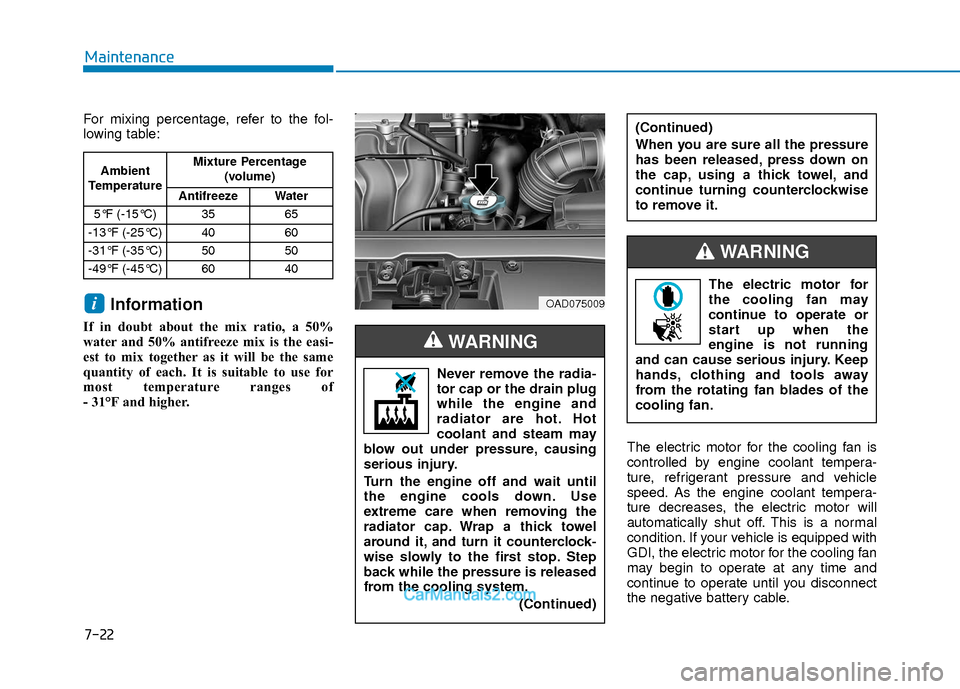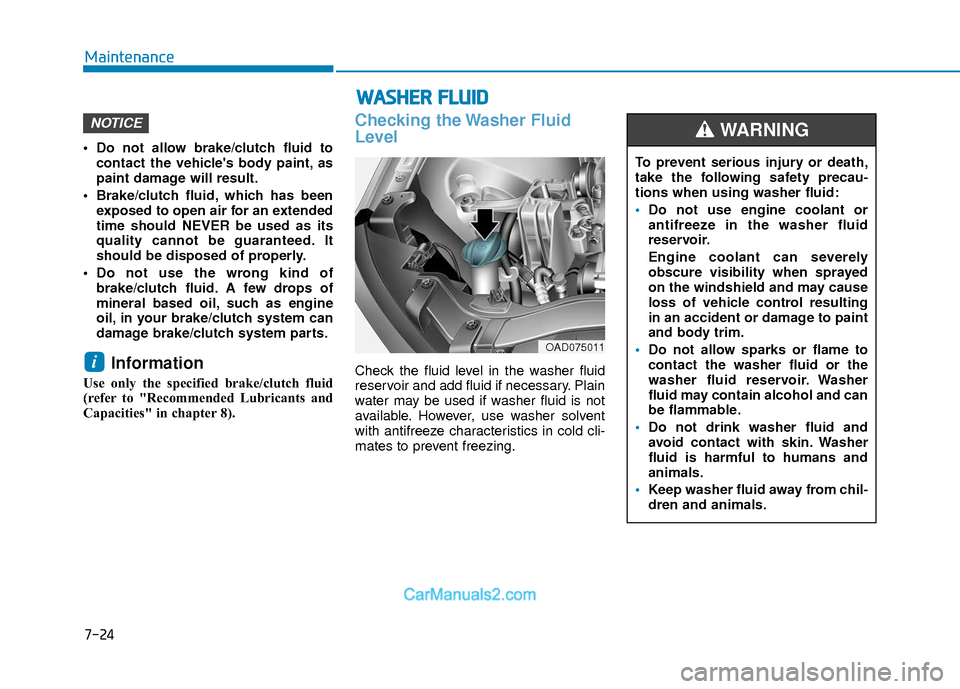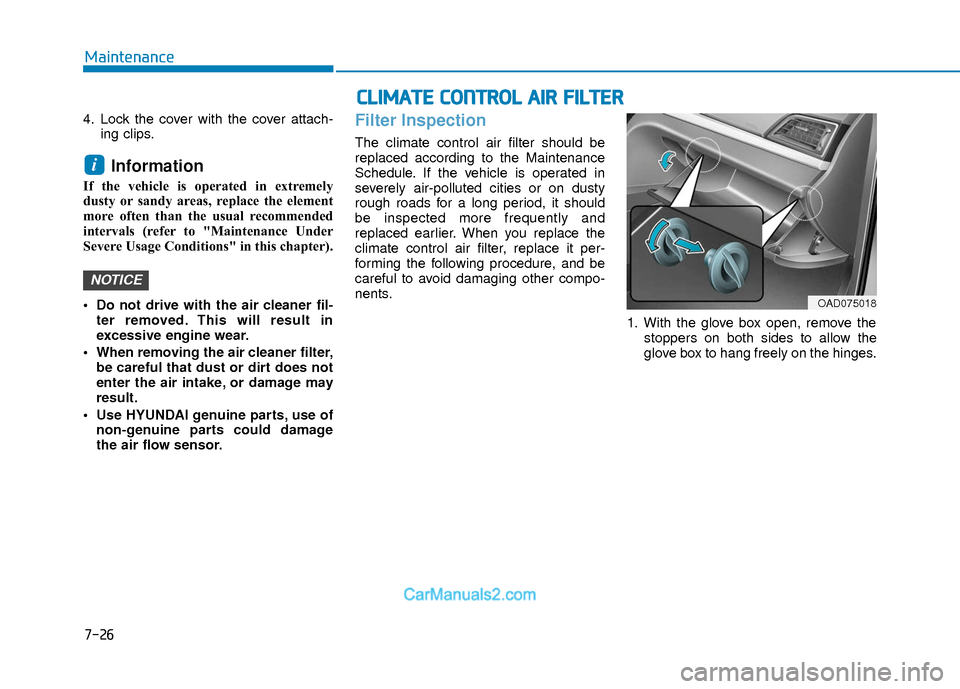Page 440 of 526

7-22
Maintenance
For mixing percentage, refer to the fol-
lowing table:
Information
If in doubt about the mix ratio, a 50%
water and 50% antifreeze mix is the easi-
est to mix together as it will be the same
quantity of each. It is suitable to use for
most temperature ranges of
- 31°F and higher.The electric motor for the cooling fan is
controlled by engine coolant tempera-
ture, refrigerant pressure and vehicle
speed. As the engine coolant tempera-
ture decreases, the electric motor will
automatically shut off. This is a normal
condition. If your vehicle is equipped with
GDI, the electric motor for the cooling fan
may begin to operate at any time and
continue to operate until you disconnect
the negative battery cable.
i
Ambient
Temperature Mixture Percentage
(volume)
Antifreeze Water
5°F (-15°C) 35 65
-13°F (-25°C) 40 60
-31°F (-35°C) 50 50
-49°F (-45°C) 60 40
Never remove the radia-
tor cap or the drain plug
while the engine and
radiator are hot. Hot
coolant and steam may
blow out under pressure, causing
serious injury.
Turn the engine off and wait until
the engine cools down. Use
extreme care when removing the
radiator cap. Wrap a thick towel
around it, and turn it counterclock-
wise slowly to the first stop. Step
back while the pressure is released
from the cooling system.
(Continued)
WARNING
(Continued)
When you are sure all the pressure
has been released, press down on
the cap, using a thick towel, and
continue turning counterclockwise
to remove it.
OAD075009
The electric motor for
the cooling fan may
continue to operate or
start up when the
engine is not running
and can cause serious injury. Keep
hands, clothing and tools away
from the rotating fan blades of the
cooling fan.
WARNING
Page 441 of 526

7-23
7
Maintenance
B
BR
RA
A K
KE
E/
/C
C L
LU
U T
TC
CH
H
F
F L
LU
U I
ID
D
Changing Engine Coolant
Have coolant changed by an authorized
HYUNDAI dealer according to the
Maintenance Schedule at the beginning
of this chapter.
To prevent damage to engine parts,
put a thick towel around the radiator
cap before refilling the coolant to pre-
vent the coolant from overflowing into
engine parts, such as the generator.
Checking the Brake/Clutch
Fluid Level
Check the fluid level in the reservoir peri-
odically. The fluid level should be
between MAX and MIN marks on the
side of the reservoir.
Before removing the reservoir cap and
adding brake/clutch fluid, clean the area
around the reservoir cap thoroughly to
prevent brake/clutch fluid contamination.
If the level is low, add the specified
brake/clutch fluid to the MAX level. The
level will fall with accumulated mileage.
This is a normal condition associated
with the wear of the brake/clutch linings.
If the fluid level is excessively low, have
the brake/clutch system checked by an
authorized HYUNDAI dealer.
NOTICE
Do not use engine coolant or
antifreeze in the washer fluid reser-
voir.
Engine coolant can severely
obscure visibility when sprayed on
the windshield and may cause loss
of vehicle control resulting in an
accident.
Engine coolant may also cause
damage to paint and body trim.
WARNING
If the brake system requires fre-
quent additions of fluid this could
indicate a leak in the brake system.
Have the vehicle inspected by an
authorized HYUNDAI dealer.
WARNING
Do not allow brake/clutch fluid to
come in contact with your eyes. If
brake/clutch fluid comes in contact
with your eyes, flush your eyes with
clean water for at least 15 minutes
and get immediate medical atten-
tion.
WARNING
OAD075010
Page 442 of 526

7-24
Maintenance
W
WA
AS
SH
H E
ER
R
F
F L
LU
U I
ID
D
Do not allow brake/clutch fluid to
contact the vehicle's body paint, as
paint damage will result.
Brake/clutch fluid, which has been exposed to open air for an extended
time should NEVER be used as its
quality cannot be guaranteed. It
should be disposed of properly.
Do not use the wrong kind of brake/clutch fluid. A few drops of
mineral based oil, such as engine
oil, in your brake/clutch system can
damage brake/clutch system parts.
Information
Use only the specified brake/clutch fluid
(refer to "Recommended Lubricants and
Capacities" in chapter 8).
Checking the Washer Fluid
Level
Check the fluid level in the washer fluid
reservoir and add fluid if necessary. Plain
water may be used if washer fluid is not
available. However, use washer solvent
with antifreeze characteristics in cold cli-
mates to prevent freezing.i
NOTICE
OAD075011
To prevent serious injury or death,
take the following safety precau-
tions when using washer fluid:
Do not use engine coolant or
antifreeze in the washer fluid
reservoir.
Engine coolant can severely
obscure visibility when sprayed
on the windshield and may cause
loss of vehicle control resulting
in an accident or damage to paint
and body trim.
Do not allow sparks or flame to
contact the washer fluid or the
washer fluid reservoir. Washer
fluid may contain alcohol and can
be flammable.
Do not drink washer fluid and
avoid contact with skin. Washer
fluid is harmful to humans and
animals.
Keep washer fluid away from chil-
dren and animals.
WARNING
Page 443 of 526
7-25
7
Maintenance
A
AI
IR
R
C
C L
LE
E A
A N
N E
ER
R
Checking the Parking Brake
Check the stroke of the parking brake by
counting the number of "clicks" heard
while fully applying it from the released
position. Also, the parking brake alone
should securely hold the vehicle on a fair-
ly steep grade. If the stroke is more or
less than specified, have the parking
brake adjusted by an authorized
HYUNDAI dealer.
Stroke : 6 clicks at a force of 44 lbs (20
kg, 196 N)
Filter Replacement
The air cleaner filter can be cleaned for
inspection using compressed air.
Do not attempt to wash or to rinse it, as
water will damage the filter.
If soiled, the air cleaner filter must be
replaced. 1. Loosen the air cleaner cover attaching
clips and open the cover.
2. Wipe the inside of the air cleaner.
3. Replace the air cleaner filter.
OAD055008
P
P A
A R
RK
K I
IN
N G
G
B
B R
RA
A K
KE
E
OAD075015OAD076013L
OAD075014
■ 1.6 T-GDI
■2.0 MPI
OAD075016
Page 444 of 526

7-26
Maintenance
4. Lock the cover with the cover attach-ing clips.
Information
If the vehicle is operated in extremely
dusty or sandy areas, replace the element
more often than the usual recommended
intervals (refer to "Maintenance Under
Severe Usage Conditions" in this chapter).
Do not drive with the air cleaner fil-ter removed. This will result in
excessive engine wear.
When removing the air cleaner filter, be careful that dust or dirt does not
enter the air intake, or damage may
result.
Use HYUNDAI genuine parts, use of non-genuine parts could damage
the air flow sensor.
Filter Inspection
The climate control air filter should be
replaced according to the Maintenance
Schedule. If the vehicle is operated in
severely air-polluted cities or on dusty
rough roads for a long period, it should
be inspected more frequently and
replaced earlier. When you replace the
climate control air filter, replace it per-
forming the following procedure, and be
careful to avoid damaging other compo-
nents.
1. With the glove box open, remove thestoppers on both sides to allow the
glove box to hang freely on the hinges.
NOTICE
i
C CL
LI
IM
M A
AT
TE
E
C
C O
O N
NT
TR
R O
O L
L
A
A I
IR
R
F
F I
IL
L T
T E
ER
R
OAD075018
Page 445 of 526
7-27
7
Maintenance
2. Remove the support rod (1).3. Remove the climate control air filter
case by pulling out the both side of the
cover. 4. Replace the climate control air filter.
5. Reassemble in the reverse order of
disassembly.
Install a new climate control air filter
in the correct direction with the arrow
symbol ( ↓ ↓) facing downwards.
Otherwise, the climate control effects
may decrease, possibly with a noise.
NOTICE
OAD075019OHG075041OAD075017
Page 446 of 526

7-28
Maintenance
W
WI
IP
P E
ER
R
B
B L
LA
A D
DE
ES
S
Blade Inspection
Contamination of either the windshield or
the wiper blades with foreign matter can
reduce the effectiveness of the wind-
shield wiper functionality. Common
sources of contamination are insects,
tree sap, and hot wax treatments used by
some commercial car washes. If the
blades are not wiping properly, clean
both the window and the blades with a
clean cloth dampened with washer fluid. To prevent damage to the wiper
blades, arms or other components, do
not:
Use gasoline, kerosene, paint thin-
ner, or other solvents on or near
them.
Attempt to move the wipers manual- ly.
Use non-specified wiper blades.
Information
Commercial hot waxes applied by auto-
matic car washes have been known to
make the windshield difficult to clean.
Blade Replacement
When the wipers no longer clean ade-
quately, the blades may be worn or
cracked, and require replacement.
To prevent damage to the wiper arms
or other components, do not attempt
to move the wipers manually.
The use of a non-specified wiper
blade could result in wiper malfunc-
tion and failure.
NOTICE
NOTICE
i
NOTICE
OLMB073019
Page 447 of 526
7-29
7
Maintenance
1. Raise the wiper arm and slightly rotatethe wiper blade assembly to expose
the plastic locking clip.
2. Press the clip (1) and slide the bladeassembly downward (2).
3. Lift it off the arm.
4. Install the blade assembly in the reverse order of removal.
5. Return the wiper arm on the wind- shield.
OLMB073020
Do not allow the wiper arm to fall
against the windshield, since it may
chip or crack the windshield.
CAUTION
OLMB073021
OLMB073022
To prevent damage to the wiper
arms or other components, have an
authorized HYUNDAI dealer replace
the wiper blade.
CAUTION